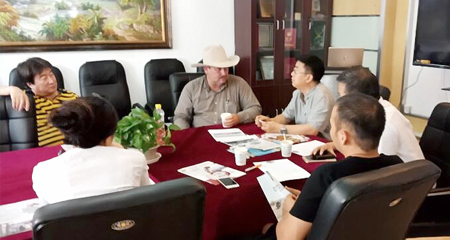
Gazprom pavilion at the St. Petersburg International Economic Forum last
year. In Europe this year and next, Gazprom will face pressure from
new LNG supplies from the U.S. and Australia.
MOSCOW—Russian state gas giant PAO Gazprom has secured a €2 billion ($2.17 billion) loan from Bank of China Ltd., the largest single-bank credit in the Russian company’s history and a sign of how Western sanctions are increasing Russia’s economic reliance on China.
The deal, announced Thursday by Gazprom, is the latest in expanding Chineseinvestment in Russia’s oil and gas sector, the country’s main export earner that has been hamstrung by U.S. sanctions barring long-term dollar lending to some Russian firms. Gazprom isn’t among those companies, but the restrictions have effectively cut off Russian companies’ access to Western capital markets.
The surge in investment is giving China, the world’s biggest energy consumer, access to Russia’s huge hydrocarbon reserves, tightening ties between the neighbors that share a desire to counterbalance U.S. influence in the world.
China agreed late last year to increase its stake in a $27 billion liquefied-natural-gas project in the Arctic that is blocked from dollar financing and is also awaiting long-hoped-for credits from Beijing. Chinese prepayments for supplies from Russian state oil firm OAO Rosneft have provided an alternative form of financing. Gazprom, which accounts for more than 10% of Russia’s export revenues, is hoping that a $55 billion project to supply gas to China will decrease its reliance on exports to Europe.
Russia has touted Asia as a funding alternative to the West, where some of its companies and banks have faced restrictions in response to its interventions in Ukraine in the past two years. A Kremlin spokesman said it was disappointed by a decision by the U.S., announced Wednesday, to extend those sanctions.
Gazprom’s loan announcement appears timed to show that Russian companies can still raise funds despite the sanctions, said Natalia Orlova, chief economist at Alfa Bank in Moscow. “Still, one shouldn’t expect that Chinese banks will replace the global capital market,” Ms. Orlova said.
Gazprom didn’t disclose further terms of the five-year loan, which will likely be used for refinancing and isn’t huge for a company with an investment program that was around 10 times as big last year, analysts said.
It could give China increased leverage in an expected renegotiation of the price of gas supplied to China, which could start flowing around the end of the decade, said Mikhail Krutikhin, a partner at the RusEnergy consulting firm.
Russia’s No. 2 gas producer, OAO Novatek, last week said it expected to seal financing soon in order to build its Arctic LNG plant. The plant, known as Yamal LNG, is slated to start gas deliveries to Asia next year.
Novatek, which is on the U.S. sanctions list, has repeatedly said in the past year that it was on the cusp of receiving funding, mainly from China. Meanwhile, it has relied on funding from the Kremlin and the plant’s owners. China National Petroleum Corp. owns a 20% stake in the Yamal LNG project, as does France’s Total SA. Chinese sovereign-wealth-fund Silk Road Fund signed a deal late last year to take a 9.9% stake.
“China is sitting in an ambush waiting for Russian companies to get into a predicament and then save them on their own terms,” Mr. Krutikhin said.
President Vladimir Putin announced in 2012 that Gazprom should look to expand eastward as it faced competition and regulatory pressure in its most-lucrative European market. But the economics of a 2014 deal, signed as tensions with the West became more strained, to make China its second-largest customer behind Germany now look less attractive because of a plunge in the price for crude oil, which Gazprom uses to form contract prices.
In Europe this year and next, Gazprom will face pressure from new LNG supplies from the U.S. and Australia.
Exports for the year “will probably be a bit lower than last year,” said Ildar Davletshin, an energy analyst at Renaissance Capital. “If it maintains flat volumes, it’ll be a good result.”

Outback Pioneers of Longreach, Australia held a workshop in Beijing on 1, June. CEO of Outback Pioneers, Mr. Richard Kinnon, presented to introduce their services and products,underlining the importance of Chinese market. Outback Pioneers is about getting to the heart of its heritage and helping Chinese visitors unleash their pioneering spirit.